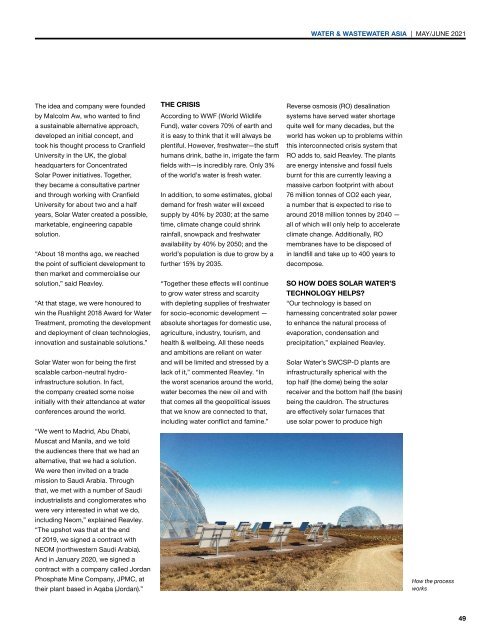Water & Wastewater Asia May/Jun 2021
Water & Wastewater Asia is an expert source of industry information, cementing its position as an indispensable tool for trade professionals in the water and wastewater industry. As the most reliable publication in the region, industry experts turn this premium journal for credible journalism and exclusive insight provided by fellow industry professionals. Water & Wastewater Asia incorporates the official newsletter of the Singapore Water Association (SWA).
Water & Wastewater Asia is an expert source of industry information, cementing its position as an indispensable tool for trade professionals in the water and wastewater industry. As the most reliable publication in the region, industry experts turn this premium journal for credible journalism and exclusive insight provided by fellow industry professionals. Water & Wastewater Asia incorporates the official newsletter of the Singapore Water Association (SWA).
Create successful ePaper yourself
Turn your PDF publications into a flip-book with our unique Google optimized e-Paper software.
WATER & WASTEWATER ASIA | MAY/JUNE <strong>2021</strong><br />
The idea and company were founded<br />
by Malcolm Aw, who wanted to find<br />
a sustainable alternative approach,<br />
developed an initial concept, and<br />
took his thought process to Cranfield<br />
University in the UK, the global<br />
headquarters for Concentrated<br />
Solar Power initiatives. Together,<br />
they became a consultative partner<br />
and through working with Cranfield<br />
University for about two and a half<br />
years, Solar <strong>Water</strong> created a possible,<br />
marketable, engineering capable<br />
solution.<br />
“About 18 months ago, we reached<br />
the point of sufficient development to<br />
then market and commercialise our<br />
solution,” said Reavley.<br />
“At that stage, we were honoured to<br />
win the Rushlight 2018 Award for <strong>Water</strong><br />
Treatment, promoting the development<br />
and deployment of clean technologies,<br />
innovation and sustainable solutions.”<br />
Solar <strong>Water</strong> won for being the first<br />
scalable carbon-neutral hydroinfrastructure<br />
solution. In fact,<br />
the company created some noise<br />
initially with their attendance at water<br />
conferences around the world.<br />
“We went to Madrid, Abu Dhabi,<br />
Muscat and Manila, and we told<br />
the audiences there that we had an<br />
alternative, that we had a solution.<br />
We were then invited on a trade<br />
mission to Saudi Arabia. Through<br />
that, we met with a number of Saudi<br />
industrialists and conglomerates who<br />
were very interested in what we do,<br />
including Neom,” explained Reavley.<br />
“The upshot was that at the end<br />
of 2019, we signed a contract with<br />
NEOM (northwestern Saudi Arabia).<br />
And in January 2020, we signed a<br />
contract with a company called Jordan<br />
Phosphate Mine Company, JPMC, at<br />
their plant based in Aqaba (Jordan).”<br />
THE CRISIS<br />
According to WWF (World Wildlife<br />
Fund), water covers 70% of earth and<br />
it is easy to think that it will always be<br />
plentiful. However, freshwater—the stuff<br />
humans drink, bathe in, irrigate the farm<br />
fields with—is incredibly rare. Only 3%<br />
of the world’s water is fresh water.<br />
In addition, to some estimates, global<br />
demand for fresh water will exceed<br />
supply by 40% by 2030; at the same<br />
time, climate change could shrink<br />
rainfall, snowpack and freshwater<br />
availability by 40% by 2050; and the<br />
world’s population is due to grow by a<br />
further 15% by 2035.<br />
“Together these effects will continue<br />
to grow water stress and scarcity<br />
with depleting supplies of freshwater<br />
for socio-economic development —<br />
absolute shortages for domestic use,<br />
agriculture, industry, tourism, and<br />
health & wellbeing. All these needs<br />
and ambitions are reliant on water<br />
and will be limited and stressed by a<br />
lack of it,” commented Reavley. “In<br />
the worst scenarios around the world,<br />
water becomes the new oil and with<br />
that comes all the geopolitical issues<br />
that we know are connected to that,<br />
including water conflict and famine.”<br />
Reverse osmosis (RO) desalination<br />
systems have served water shortage<br />
quite well for many decades, but the<br />
world has woken up to problems within<br />
this interconnected crisis system that<br />
RO adds to, said Reavley. The plants<br />
are energy intensive and fossil fuels<br />
burnt for this are currently leaving a<br />
massive carbon footprint with about<br />
76 million tonnes of CO2 each year,<br />
a number that is expected to rise to<br />
around 2018 million tonnes by 2040 —<br />
all of which will only help to accelerate<br />
climate change. Additionally, RO<br />
membranes have to be disposed of<br />
in landfill and take up to 400 years to<br />
decompose.<br />
SO HOW DOES SOLAR WATER’S<br />
TECHNOLOGY HELPS?<br />
“Our technology is based on<br />
harnessing concentrated solar power<br />
to enhance the natural process of<br />
evaporation, condensation and<br />
precipitation,” explained Reavley.<br />
Solar <strong>Water</strong>’s SWCSP-D plants are<br />
infrastructurally spherical with the<br />
top half (the dome) being the solar<br />
receiver and the bottom half (the basin)<br />
being the cauldron. The structures<br />
are effectively solar furnaces that<br />
use solar power to produce high<br />
How the process<br />
works<br />
49


















